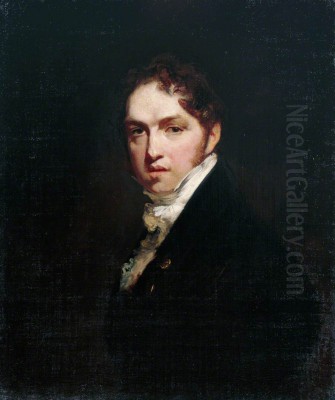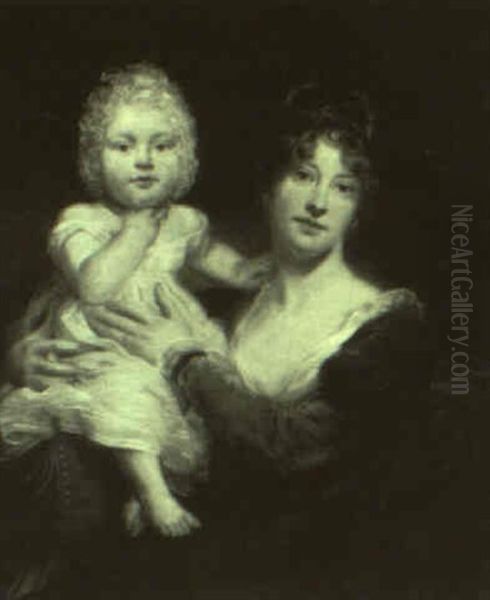
William Owen stands as a significant figure in British portrait painting during the late Georgian and Regency periods. Born in Ludlow, Shropshire, in 1769 (though some sources state Llanfihangel-y-Pennant, Wales), and passing away in London in 1825, Owen navigated the vibrant and competitive London art world to achieve considerable success, including prestigious royal appointments. His career coincided with a golden age of British portraiture, placing him alongside some of the most celebrated names in the nation's art history.
Owen's journey into the art world began with formal training. After showing early promise, he was sent to London around 1786. There, he became a pupil of Charles Catton the Younger, RA (1756–1819), a coach painter, landscape, and animal artist who had followed his own father into the Royal Academy. This apprenticeship provided Owen with a solid foundation in the technical aspects of painting, essential for any aspiring artist in the capital.
The London art scene in the late 1780s and 1790s was dominated by towering figures. Sir Joshua Reynolds (1723–1792), the first President of the Royal Academy, was still the leading portraitist, though nearing the end of his illustrious career. Thomas Gainsborough (1727–1788) had recently passed away, but his fluid style remained influential. Other established names included George Romney (1734–1802), known for his elegant depictions of society beauties, and the American-born Benjamin West (1738–1820), who succeeded Reynolds as President of the Royal Academy and specialized in historical subjects as well as portraits.
Early Recognition and Academic Success
Owen's talent did not go unnoticed for long. Crucially, his early work is said to have attracted the favourable attention of Sir Joshua Reynolds himself. While the exact nature of their interaction is unclear, recognition, or even perceived approval, from the preeminent figure in British art would have been an invaluable boost to a young painter's reputation and confidence. Reynolds's influence, particularly his 'Grand Manner' style which aimed to elevate portraiture by incorporating classical references and poses, shaped the aspirations of many artists of the period.

Owen began exhibiting at the Royal Academy of Arts in 1792, the year of Reynolds's death. This institution was the epicentre of the London art world, and regular exhibition there was vital for securing patronage and building a career. Owen quickly established himself as a capable portraitist. His skill in capturing a sitter's likeness, combined with a competent technique, led to a steady stream of commissions.
His progress within the academic system was relatively swift. In 1804, Owen was elected an Associate of the Royal Academy (ARA), a significant step indicating recognition by his peers. Just two years later, in 1806, he achieved the highest rank, becoming a full Royal Academician (RA). This honour cemented his position within the artistic establishment and placed him among the leading painters of the day, alongside contemporaries like John Hoppner (1758–1810) and the rapidly rising star, Thomas Lawrence (1769–1830).
Portrait Painter to the Prince
A pivotal moment in Owen's career arrived in 1810 when he was appointed portrait painter to George, the Prince of Wales (1762–1830). The Prince, known for his extravagant tastes and patronage of the arts, became Prince Regent in 1811 due to his father King George III's illness. This royal connection was immensely prestigious and undoubtedly increased Owen's standing and workload. In 1813, his position was further elevated when he was named Principal Portrait Painter to the Prince Regent.
This appointment placed Owen in direct competition with Sir Thomas Lawrence, who was also heavily favoured by the Regent and arguably became the dominant portraitist of the era. While Lawrence's style was often characterized by its dazzling brushwork and fashionable flair, Owen offered a perhaps more solid, less flamboyant, but equally skilled alternative. Both artists painted numerous members of the royal family and the surrounding court circle.
Owen's success during this period is reflected in his reported income, said to average around £3,000 per year – a very substantial sum at the time. His services were clearly in high demand among the aristocracy and gentry. Despite this success and his royal appointment, it is noted that Owen later declined the offer of a knighthood, although the reasons for this refusal are not specified. Perhaps it reflected a certain modesty or a desire to avoid the obligations that might accompany the title.
Artistic Style and Approach
While detailed contemporary analyses of Owen's specific stylistic nuances are less common than for figures like Reynolds or Lawrence, we can infer characteristics from his known works and the context of the time. His training under Catton and the influence of Reynolds likely instilled a strong emphasis on draughtsmanship and solid composition. His portraits are generally known for their reliable likenesses – a crucial factor for securing commissions.
Compared to the often dramatic and psychologically penetrating portraits of Reynolds, or the brilliant, sometimes superficial, glamour of Lawrence, Owen's work can appear more straightforward and less ostentatious. However, this should not be mistaken for a lack of skill. His handling of paint was proficient, and he could render textures, such as fabrics and flesh tones, effectively. His colouring is often described as rich and harmonious.
He worked within the established conventions of British portraiture, often employing standard formats (bust-length, half-length, full-length) and poses derived from the Grand Manner tradition. However, his work also reflects the transition towards the slightly softer, more Romantic sensibility emerging in the early 19th century. There is often a quiet dignity and a sense of character captured in his sitters, without resorting to excessive flattery or dramatic effect. He painted men and women with equal facility, adapting his approach to suit the individual.
Other portraitists active during Owen's peak years included the Scottish master Sir Henry Raeburn (1756–1823), known for his vigorous, direct style, particularly in male portraiture. In America, Gilbert Stuart (1755–1828), who had spent time working in London earlier, was developing his own distinct approach to capturing likeness. Within the Royal Academy itself, female artists like Angelica Kauffman (1741–1807) and Mary Moser (1744–1819), though perhaps facing different challenges, had earlier achieved RA status, demonstrating the breadth of talent within the institution.
Notable Works and Sitters
William Owen's oeuvre consists primarily of portraits, depicting many prominent figures of his time. Among his most important sitters was the Prince Regent himself, later King George IV. Painting the monarch or heir apparent was the pinnacle of portraiture success, and Owen executed likenesses of the Prince that were valued for their accuracy.
He also painted leading politicians, lawyers, aristocrats, and intellectuals. A well-known example is his portrait of William Pitt the Younger (1759–1806), the influential Prime Minister. Although Pitt died in 1806, the year Owen became an RA, portraits of such major figures were often commissioned posthumously or copied.
Another significant legal and political figure captured by Owen was Alexander Wedderburn, 1st Earl of Rosslyn (1733–1805), who served as Lord Chancellor (under the title Lord Loughborough). Owen's portrait of Rosslyn, likely painted towards the end of the sitter's life or shortly after, is held in high regard and showcases his ability to convey gravitas and intellectual presence.
He also painted the Irish orator and lawyer John Philpot Curran (1750–1817). Portraits of figures known for their intellect or public speaking often required the artist to capture a sense of their inner life or professional persona, a challenge Owen met successfully.
Owen didn't exclusively paint men in positions of power. He also produced sensitive portraits of women and children. One documented work is a half-length portrait of Dorothy Margaret Westmacott. She was the wife of the prominent sculptor Sir Richard Westmacott RA (1775–1856), another key figure in the London art world. Painting the spouse of a fellow Academician highlights the close-knit nature of the artistic community.
Beyond commissioned portraits, Owen occasionally painted 'fancy pictures' or genre subjects, which were popular at the time. Works like The Beggar's Daughter of Bethnal Green, The Schoolmistress, or a simple Mother and Child allowed for more imaginative compositions and narrative elements, diverging from the demands of formal portraiture. A work titled Portrait of an Old Woman is also mentioned, suggesting an interest in character studies beyond the wealthy elite. His portrait of the pioneering industrialist and pottery magnate Josiah Wedgwood (1730-1795) is another notable work, likely painted from an existing likeness or based on earlier depictions, given Wedgwood's death date relative to Owen's main period of activity.
Context within the London Art World
Owen operated during a period of immense artistic activity and shifting tastes in Britain. The Royal Academy exhibitions were major social events, and the press reviewed them extensively. Artists competed fiercely for commissions and critical acclaim. Portraiture was particularly lucrative, as the aristocracy, the rising middle classes, and public institutions all sought likenesses to record status, commemorate achievements, or express familial affection.
The era saw the continued dominance of oil painting, but watercolour was also gaining status, particularly for landscapes, championed by artists like J.M.W. Turner (1775–1851) and Thomas Girtin (1775–1802). While Owen focused on oils and portraiture, the broader artistic environment was rich and varied. Sculptors like Westmacott and Sir Francis Chantrey (1781–1841) were also highly successful, often creating busts or monuments of the same individuals Owen painted.
The Napoleonic Wars (1803–1815) formed a dramatic backdrop to much of Owen's career. This period of national crisis paradoxically fueled a demand for portraits of military heroes and political leaders, while also fostering a strong sense of national identity that patrons sought to express through art. Owen, as a leading portraitist, benefited from this climate.
His relationship with contemporaries like Sir Thomas Lawrence would have been complex – likely a mixture of professional respect and intense rivalry. Both men sought the same prestigious commissions, particularly from the Prince Regent. Lawrence's star ultimately shone brighter, especially after Owen's death, as he came to define the visual style of the Regency and reign of George IV. However, during his lifetime, Owen maintained a successful and respected practice. He also worked alongside other portraitists like Martin Archer Shee (1769–1850), who would later become President of the Royal Academy.
Later Life and Legacy
William Owen continued to paint actively throughout the 1810s and into the early 1820s, maintaining his position as a favoured portraitist. His health, however, reportedly declined in his later years. He passed away in London on February 11, 1825, at the age of 55 or 56. His death was apparently caused not by his underlying illness, but by accidentally ingesting poison due to a mistake by a chemist or apothecary – a tragically mundane end for a successful artist.
In the annals of British art history, William Owen is remembered as a highly competent and successful portrait painter of the Regency era. He achieved the highest academic honours and secured coveted royal patronage. While perhaps lacking the innovative genius of Reynolds or the dazzling virtuosity of Lawrence, his work possesses a solid quality, a faithfulness to likeness, and a quiet dignity that appealed greatly to his contemporaries.
His portraits provide valuable visual records of many key figures from a transformative period in British history. He represents the high standard of professional portraiture available in London at the time, serving the needs of a society eager to see itself represented in art. Though sometimes overshadowed by the more famous names of his day, William Owen was a significant contributor to the rich tapestry of British painting, a Royal Academician whose skill and professionalism earned him a distinguished place in the art world of his time. His work can be found in major collections, including the National Portrait Gallery in London and the Royal Collection.